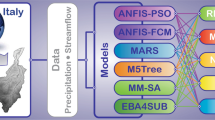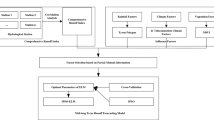Abstract
A new hybrid data-driven model named PBK has been proposed to improve the event-based rainfall–runoff simulation. The PBK is developed by coupling partial mutual information-based input variable selection (IVS), ensemble back-propagation neural network (EBPNN)-based discharge forecasting and K-nearest neighbor algorithm-based discharge error forecasting. This model is proposed for solving the hard problem of how to implement non-updating rainfall–runoff simulation by data-driven models. For the purpose of solving the hard problems, the PBK model has the following innovations and improvements: (1) a newly proposed non-updating modeling approach without the using of the real-time information and can obtain higher simulation accuracy; (2) a newly proposed IVS scheme and a newly proposed candidate rainfall input set to ensure the adequacy and parsimony of the rainfall and antecedent discharge input variables; and (3) a newly proposed calibration method for the EBPNN to ensure higher simulation accuracy and better generalization property. This method is a combination of the NGSA-II, Levenberg–Marquardt algorithm, and the AIC-based combination weights generating method. For the purpose of comparing simulation accuracy with traditional non-updating data-driven models, a back-propagation neural network model (PB_R) and a linear model (CLS) were also studied. This study utilized event flood data of Dongwan catchment for intercomparisons between different models. The simulation results indicated that the PBK model outperforms other data-driven models and has higher accuracy and better forecasting capability.








Similar content being viewed by others
Explore related subjects
Discover the latest articles and news from researchers in related subjects, suggested using machine learning.References
Adamowski J, Chan HF, Prasher SO, Sharda VN (2012) Comparison of multivariate adaptive regression splines with coupled wavelet transform artificial neural networks for runoff forecasting in Himalayan micro-watersheds with limited data. J Hydroinform 044:731–744
Akaike H (1974) A new look at the statistical model identification. IEEE Trans Autom Control 19:716–723
Bowden GJ, Dandy GC, Maier HR (2005) Input determination for neural network models in water resources applications. Part 1—background and methodology. J Hydrol 301:75–92
Bowden GJ, Maier HR, Dandy GC (2005) Input determination for neural network models in water resources applications. Part 2. Case study: forecasting salinity in a river. J Hydrol 301(1–4):93–107
Chiang Y, Chang L, Chang F (2004) Comparison of static-feedforward and dynamic feedback neural networks for rainfall–runoff modeling. J Hydrol 290:297–311
Chua HCL, Wong TSW, Sriramula LK (2008) Comparison between kinematic wave and artificial neural network models in event-based runoff simulation for an overland plane. J Hydrol 357:337–348
Coulibaly P, Anctil F, Bobée B (2000) Daily reservoir inflow forecasting using artificial neural networks with stopped training approach. J Hydrol 230:244–257
Dastorani MT, Koochi JS, Darani HS, Talebi A, Rahimian MH (2013) River instantaneous peak flow estimation using daily flow data and machine-learning-based models. J Hydroinform 245:1089–1098
Dawson CW, See LM, Abrahart RJ, Heppenstall AJ (2006) Symbiotic adaptive neuron-evolution applied to rainfall–runoff modelling in northern England. Neural Netw 19(2):236–247
Dawson CW, Mount NJ, Abrahart RJ, Louis J (2013) Sensitivity analysis for comparison, validation and physical legitimacy of neural network-based hydrological models. J Hydroinform 222:407–424
Deb K (2001) Multi-objective optimization using evolutionary algorithms. Wiley, Chichester
Deb K, IEEE AM, Pratap A, Agarwal S, Meyarivan T (2002) A fast and elitist multiobjective genetic algorithm: NSGA-II. IEEE Trans Evol Comput 6(2):182–197
Ding S, Su C, Yu J (2011) An optimizing BP neural network algorithm based on genetic algorithm. Artif Intell Rev 36:153–162
Galeati G (1990) A comparison of parametric and non-parametric methods for runoff forecasting. Hydrol Sci J 35(1):79–94
He J, Valeo G, Chu A, Neumann Norman F (2011) Prediction of event-based stormwater runoff quantity and quality by ANNs developed using PMI-based input selection. J Hydrol 400:10–23
Jain A, Indurthy SKVP (2003) Comparative analysis of event-based rainfall–runoff modeling techniques—deterministic, statistical and artificial neural networks. J Hydrol Eng 8(2):93–98
Ju Q, Yu Z, Hao Z, Ou G, Zhao J, Liu D (2009) Division-based rainfall–runoff simulations with BP neural networks and Xinanjiang model. Neurocomputing 72:2873–2883
Kan G, Yao C, Li Q, Li Z, Yu Z, Liu Z, Ding L, He X, Liang K (2015) Improving event-based rainfall–runoff simulation using an ensemble artificial neural network based hybrid data-driven model. Stoch Environ Res Risk Assess. doi:10.1007/s00477-015-1040-6
Kanal L (1974) Patterns in pattern recognition. IEEE Trans Inf Theory 20:697–722
Karlsson M, Yakowitz S (1987) Nearest neighbour methods for non-parametric rainfall runoff forecasting. Water Resour Res 23(7):1300–1308
Karran DJ, Morin E, Adamowski J (2013) Multi-step streamflow forecasting using data-driven non-linear methods in contrasting climate regimes. J Hydroinform 042:671–709
Krause P, Boyle DP, Bäse F (2005) Comparison of different efficiency criteria for hydrological model assessment. Adv Geosci 5:89–97
Kumar ARS, Sudheer KP, Jain SK, Agarwal PK (2005) Rainfall–runoff modeling using artificial neural networks: comparison of network types. Hydrol Process 19:1277–1291
Lee KT, Hung WC, Meng CC (2008) Deterministic insight into ANN model performance for storm runoff simulation. Water Resour Manag 22:67–82
Li Z, Kan G, Yao C, Liu Z, Li Q, Yu S (2014) An improved neural network model and its application in hydrological simulation. J Hydrol Eng 19(10):04014019-1–04014019-17
Loghmanian SMR, Ahmad HJR, Khalid RYM (2012) Structure optimization of neural network for dynamic system modeling using multi-objective genetic algorithm. Neural Comput Appl 21:1281–1295
May RJ, Dandy GC, Maier HR, Nixon JB (2008) Application of partial mutual information variable selection to ANN forecasting of water quality in water distribution systems. Environ Model Softw 23(10–11):1289–1299
Minns AW, Hall MJ (1996) Artificial neural networks as rainfall–runoff models. Hydrol Sci J 41(3):399–417
Nash JE, Sutcliffe JV (1970) River flow forecasting through conceptual models; part I—a discussion of principles. J Hydrol 10:282–290
Natale N, Todini E (1974) A constrained parameter estimation technique for linear models in hydrology. Publ. 13, Institute of Hydraulics, University of Pavia
Panchal G, Ganatra A, Kosta YP (2010) Searching most efficient neural network architecture using Akaike’s information criterion (AIC). Int J Comput Appl 1(5):975–8887
Piotrowski AP, Napiorkowski JJ (2013) A comparison of methods to avoid overfitting in neural networks training in the case of catchment runoff modeling. J Hydrol 476:97–111
Seckin N (2010) Modeling flood discharge at ungauged sites across Turkey using neuro-fuzzy and neural networks. J Hydroinform 046:842–849
Shamseldin AY, O’Connor KO (1996) A nearest neighbour linear perturbation model for river flow forecasting. J Hydrol 179:352–375
Sharma A (2000) Seasonal to interannual rainfall probabilistic forecasts for improved water supply management: part 1—a strategy for system predictor identification. J Hydrol 239(1–4):232–239
Sharma A (2000) Seasonal to interannual rainfall probabilistic forecasts for improved water supply management: part 3—a nonparametric probabilistic forecast model. J Hydrol 239(1–4):249–258
Sollich P, Krogh A (1996) Learning with ensembles: how over-fitting can be useful. In: Touretzky DS, Mozer MC, Hasselmo ME (eds) Advances in neural information processing systems, vol 8. MIT Press, Cambridge, MA, pp 190–196
Soroosh S, Arash M (2012) A novel hybrid mechanistic-data-driven model identification framework using NSGA-II. J Hydroinform 026:697–715
Srinivas N, Deb K (1994) Multi-objective optimization using non-dominated sorting in genetic algorithms. Evol Comput 2(3):221–248
Tayfur G, Singh VP (2006) ANN and fuzzy logic models for simulating event-based rainfall–runoff. J Hydraul Eng ASCE 132(12):1321–1330
Tiwari MK, Song K-Y, Chatterjee C, Gupta MM (2012) Improving reliability of river flow forecasting using neural networks, wavelets and self-organising maps. J Hydroinform 130:486–502
Todini E, Wallis JR (1974) Using CLS for daily or longer period rainfall–runoff modeling. Publ. 13, Institute of Hydraulics, University of Pavia
Tokar AS, Markus M (2000) Rainfall–runoff modeling using artificial neural networks and conceptual models. J Hydrol Eng 5(2):156–161
Vahid N, Masoumeh P (2013) Conjunction of SOM-based feature extraction method and hybrid wavelet-ANN approach for rainfall–runoff modeling. J Hydroinform 141:829–848
Wang J, Zhang R, Xu G (1985) Constrained linear system model and its application in flood forecasting of the Han River. J China Hydrol 1:8–16 (in Chinese)
Wang J, Zhang R, Xu G (1987) Synthesized constrained linear system. J Hydraul Eng ASCE 7:1–9 (in Chinese)
Wei S, Zuo D, Song J (2012) Improving prediction accuracy of river discharge time series using a Wavelet-NAR artificial neural network. J Hydroinform 143:974–991
Yakowitz S (1987) Nearest neighbor methods for time series analysis. J Time Ser Anal 8(2):235–247
Yu J, Wang S, Xi L (2008) Evolving artificial neural networks using an improved PSO and DPSO. Neurocomputing 71:1054–1060
Zhang D, Cai K (2003) A genetic-algorithm-based two-stage learning scheme for neural networks. J Syst Sin 15(8):1088–1090 (in Chinese)
Zhao Z, Zhang Y, Liao H (2008) Design of ensemble neural network using the Akaike information criterion. Eng Appl Artif Intell 21:1182–1188
Acknowledgments
This research was funded by the IWHR Scientific Research Projects of Outstanding Young Scientists “Research and application on the fast global optimization method for the Xinanjiang model parameters based on the high-performance heterogeneous computing”, the Study on Mass-Energy Balance Coupling Scheme on Hill-Slope and Its Application to Distributed Hydrological Models (No. 51420105014), the Third Sub-Project: Flood Forecasting, Controlling and Flood Prevention Aided Software Development—Flood Control Early Warning Communication System and Flood Forecasting, Controlling and Flood Prevention Aided Software Development for Poyang Lake Area of Jiangxi Province (0628-136006104242, JZ0205A432013, SLXMB200902), the Numerical Simulation Technology of Flash Flood based on Godunov Scheme and Its Mechanism Study by Experiment (51509263), the Mayor Seismic-Geological Disaster Chains Process and Disaster Risk Comprehensive Assessment—supported by National Sci-Tech Support Plan (2012bak10b03-02), the IWHR Special Dynamic Investigation Project on International Water Resources and Hydropower Technology Development—Progress Summary and Comment on the Research of Dynamic Control of Reservoir Water Level During Flood Season (JZ0145C102015), and the NNSF of China, Estimation of regional evapotranspiration using remotely sensed data based on the theoretical VFC/LST trapezoid space (No. 41501415). We gratefully acknowledge the support of NVIDIA Corporation with the donation of the Tesla K40 GPU used for this research.
Author information
Authors and Affiliations
Corresponding author
Rights and permissions
About this article
Cite this article
Kan, G., Li, J., Zhang, X. et al. A new hybrid data-driven model for event-based rainfall–runoff simulation. Neural Comput & Applic 28, 2519–2534 (2017). https://doi.org/10.1007/s00521-016-2200-4
Received:
Accepted:
Published:
Issue Date:
DOI: https://doi.org/10.1007/s00521-016-2200-4




